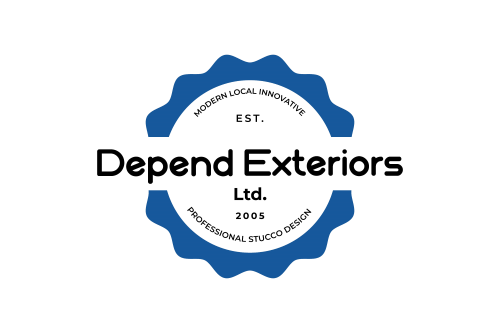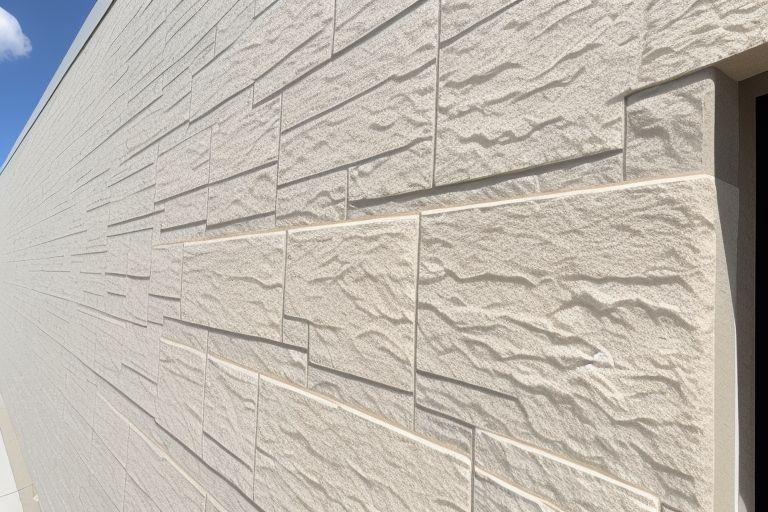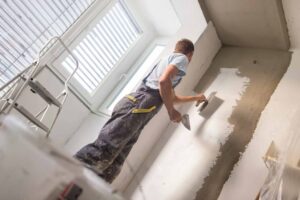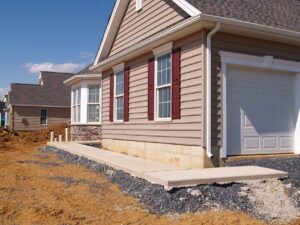EIFS Installation Guide
EIFS installation is a detailed process that requires careful planning and expertise to ensure a long-lasting and efficient exterior system. Whether you’re considering EIFS for a residential or commercial building, understanding each step of the installation process will help set expectations and ensure the best results.
In this guide, we’ll cover:
- Step 1: Pre-Installation Planning and Site Preparation – Ensuring the substrate is clean, dry, and stable.
- Step 2: Installing a Water-Resistant Barrier and Flashing – Preventing moisture intrusion with a proper WRB system.
- Step 3: Attaching the Insulation Board – Providing continuous thermal protection.
- Step 4: Applying the Base Coat and Reinforcing Mesh – Enhancing strength and impact resistance.
- Step 5: Curing the Base Coat – Allowing proper drying for long-term durability.
- Step 6: Applying the Finish Coat – Achieving aesthetic appeal and weather protection.
- Step 7: Final Inspection and Touch-Ups – Ensuring a flawless finish.
- Step 8: Cleanup and Site Restoration – Leaving your property clean and ready for use.
Keep reading to learn what to expect during EIFS installation and how to ensure a smooth and successful process!
If you have more questions or need EIFS services in Edmonton, AB, call (780) 710-3972.
Exterior Insulation and Finish Systems (EIFS) Installation Guide: What to Expect
EIFS installation requires precise planning, proper material selection, and careful execution. Below is a step-by-step guide detailing what happens during EIFS installation.
Step 1: Pre-Installation Planning and Site Preparation
Proper planning ensures a smooth installation process and prevents common issues such as moisture retention, poor adhesion, and system failure.
✅ What Happens?
- The building surface is assessed for suitability. Common substrates include concrete, masonry, and sheathing panels.
- The site is inspected for moisture issues, ensuring the substrate is clean, dry, and structurally sound.
- Expansion joints are planned to accommodate building movement and thermal expansion.
- A project timeline is established, considering weather conditions and drying times.
✅ Why This Step Matters:
- Prevents early system failure due to poor adhesion.
- Reduces water infiltration risks by addressing potential moisture problems.
- Ensures efficient workflow for a quicker, smoother installation process.
How Should I Prepare for EIFS Installation?
Proper preparation before EIFS installation ensures a smooth process, fewer delays, and a successful long-term outcome.
✅ What You Need to Do:
- Schedule a Professional Inspection: Ensure the building’s structure is suitable for EIFS and identify potential moisture issues.
- Check for Permits and Regulations: Confirm compliance with local building codes and obtain necessary permits.
- Clear the Work Area: Remove furniture, vehicles, or landscaping obstructions near the installation site.
- Plan for Weather Conditions: EIFS installation requires temperatures above 40°F (4°C) and dry conditions.
- Ensure Access to Utilities: Installers may require power sources and water access to mix materials and apply coatings.
- Communicate with Your Contractor: Discuss colour options, textures, timelines, and expectations to ensure the final result meets your needs.
✅ Why This Step Matters:
- Avoids unexpected delays caused by unprepared surfaces or missing permits.
- Ensures a stable, dry, and clean substrate for proper adhesion.
- Helps homeowners and businesses plan around installation disruptions.
Step 2: Installing a Water-Resistant Barrier and Flashing
A water-resistant barrier (WRB) and flashing system help divert water from the building’s interior.
✅ What Happens?
- A liquid-applied or mechanically fastened WRB is applied over the substrate.
- Flashing is installed around windows, doors, and penetrations to prevent water infiltration.
- The system is inspected to ensure complete coverage with no gaps or exposed areas.
✅ Why This Step Matters:
- Adds an extra layer of moisture protection to prevent trapped water.
- Ensures EIFS durability in high-rainfall or humid environments.
- Protects structural integrity by preventing water damage.
Step 3: Attaching the Insulation Board
The insulation board is the core of the EIFS system, providing thermal efficiency and a smooth base for subsequent layers.
✅ What Happens?
- Expanded Polystyrene (EPS) or other approved insulation boards are measured and cut for precise fitment.
- Boards are attached using adhesive, mechanical fasteners, or a combination of both, depending on the substrate.
- Joints between boards are staggered to enhance stability and minimize thermal bridging.
- Any gaps are filled with low-expansion foam or adhesive to prevent air leaks.
✅ Why This Step Matters:
- It provides continuous insulation, reducing heat loss and improving energy efficiency.
- Ensures a level surface for base coat application, preventing weak spots.
- Reduces air infiltration, which helps maintain indoor comfort levels.
Step 4: Applying the Base Coat and Reinforcing Mesh
The base coat and reinforcing mesh layer add strength and impact resistance to the EIFS system.
✅ What Happens?
- A polymer-modified cementitious base coat is applied evenly over the insulation board.
- Fiberglass reinforcing mesh is embedded into the wet base coat for added flexibility and strength.
- Multiple layers of mesh may be used in high-impact areas for extra durability.
- The surface is smoothed to remove irregularities before curing.
✅ Why This Step Matters:
- Prevents cracking due to building movement or temperature fluctuations.
- Increases impact resistance, reducing damage from accidental hits.
- Forms a strong foundation for the final finish coat.
Step 5: Curing the Base Coat
The curing phase ensures proper adhesion and longevity of the EIFS system.
✅ What Happens?
- The base coat is left to cure for at least 24–48 hours, depending on temperature and humidity.
- The installation team monitors curing conditions, avoiding direct sun exposure, wind, or rain that can affect drying.
✅ Why This Step Matters:
- Ensures the system’s optimal strength and flexibility.
- Prevents premature cracking or delamination caused by improper drying.
- Creates a stable surface for the finish coat application.
Step 6: Applying the Finish Coat
The finish coat is the final protective layer, adding texture, colour, and weather resistance.
✅ What Happens?
- A high-quality acrylic or polymer-based finish coat is applied using trowels, sprayers, or rollers.
- Different textures and colours are chosen to match the building’s design.
- The finish coat is left to dry completely, ensuring proper adhesion.
✅ Why This Step Matters:
- Protects EIFS from UV damage, moisture, and weathering.
- Provides an aesthetic and uniform appearance.
- Enhances long-term durability and maintenance ease.
Step 7: Final Inspection and Touch-Ups
Before project completion, a final quality check ensures the EIFS system meets industry standards.
✅ What Happens?
- The installation is inspected for cracks, uneven areas, or missed sections.
- Sealants around windows, doors, and penetrations are checked and reinforced if necessary.
- Any touch-ups are made to ensure a flawless appearance.
✅ Why This Step Matters:
- Confirms installation compliance with EIFS manufacturer guidelines.
- Prevents long-term issues by addressing minor imperfections early.
- Ensures a professional, high-quality finish.
Step 8: Cleanup and Site Restoration
After installation, proper cleanup ensures a safe and tidy worksite.
✅ What Happens?
- Excess materials, debris, and scaffolding are removed from the site.
- Protective coverings on adjacent surfaces are taken down.
- The property is returned to its original state, leaving a clean, finished look.
✅ Why This Step Matters:
- Enhances customer satisfaction by leaving the site neat.
- Prevents accidental damage to other building elements.
- Ensures safety for occupants and workers.
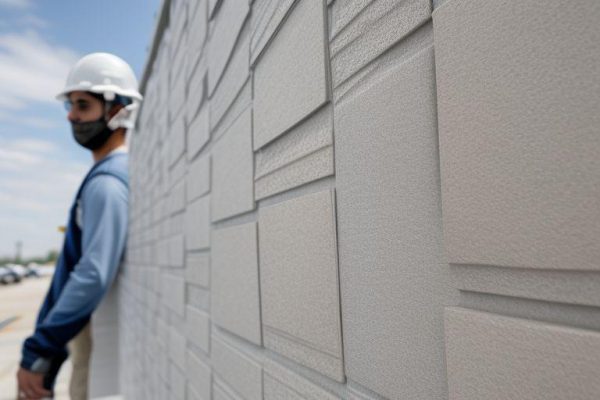
How to Care for EIFS After Installation
Proper EIFS maintenance preserves durability, aesthetics, and energy efficiency. Follow these steps to ensure your EIFS lasts for decades.
- Perform Regular Inspections
Conduct biannual inspections to check for cracks, discoloration, bulging, or moisture stains. Pay special attention to sealants around windows and doors, as these areas are prone to wear.
- Keep EIFS Surfaces Clean
Wash EIFS with mild detergent and low-pressure water to remove dirt, dust, and mildew. Avoid high-pressure washing, as it can damage the finish.
- Address Minor Repairs Quickly
Seal small cracks and chips immediately to prevent moisture penetration. Use EIFS-compatible sealants to maintain the system’s waterproofing properties.
- Maintain Expansion Joints
Ensure expansion joints remain flexible and intact to accommodate building movement. Replace any deteriorated caulking.
- Protect EIFS from Impact Damage
Avoid leaning ladders, tools, or heavy objects against EIFS walls. Install protective barriers in high-traffic areas.
- Reapply Paint and Coatings as Needed
Use breathable EIFS-compatible coatings every 10–15 years to maintain the colour and UV protection of the finish.
- Check for Moisture Issues
If you suspect trapped moisture, schedule a professional EIFS moisture inspection. Early detection prevents costly repairs.
What Is EIFS?
Exterior Insulation and Finish Systems (EIFS) is a multi-layered cladding system that provides insulation, moisture control, and an aesthetically appealing finish. EIFS consists of an insulation board, a reinforced base coat, and a textured finish coat, offering superior energy efficiency and durability compared to traditional stucco.
Benefits of EIFS:
- Energy Efficiency: Reduces heating and cooling costs by providing continuous insulation.
- Moisture Resistance: Modern EIFS systems with drainage layers prevent water retention.
- Design Flexibility: Available in various textures, colours, and finishes.
- Lightweight & Durable: Less stress on building structures with impact-resistant coatings.
- Long Lifespan: EIFS can last 30–60 years when properly installed and maintained.
How Much Does It Cost to Install EIFS?
EIFS installation costs depend on several factors, including the project size, system type, labour costs, and regional pricing.
Average EIFS Installation Costs:
- Basic EIFS Installation: 8 CAD to 15 CAD per square foot.
- EIFS with Drainage System: 6 CAD -12 CAD per square foot.
- High-Impact EIFS (Commercial-Grade): CAD10–CAD16 per square foot.
Depend Exteriors Offers Professional EIFS Installation
Depend Exteriors specializes in professional EIFS installation, providing energy-efficient, durable, and weather-resistant exterior solutions for residential and commercial buildings in Edmonton, Alberta.
Our expert team ensures proper surface preparation, insulation board attachment, and moisture management for long-lasting performance. With high-quality materials, precision craftsmanship, and advanced sealing techniques, we help prevent moisture retention, cracking, and structural issues. Whether you need new EIFS installation or repairs, trust Depend Exteriors for exceptional results.
📞 Call (780) 710-3972 today for a free consultation and estimate!
FAQs
What is the downside of EIFS?
The main downside of EIFS is its susceptibility to moisture retention if not properly installed or maintained. Without a drainage system, trapped water can cause mould, wood rot, and structural damage. EIFS is also less impact-resistant than traditional stucco, making it prone to dents and cracks from physical damage.
What is the main structural problem when EIFS is improperly installed?
The biggest structural issue with improperly installed EIFS is moisture infiltration due to poor sealing, inadequate drainage, or missing flashing. When water gets trapped behind the system, it can lead to mould growth, wood rot, and substrate deterioration, compromising the building’s structural integrity.
How do you seal and maintain Exterior Insulation Finish Systems (EIFS)?
To properly seal and maintain EIFS:
✔ Inspect Annually – Check for cracks, discoloration, or moisture damage.
✔ Reapply Sealants – Replace caulking around windows, doors, and joints every 5–10 years.
✔ Clean Gently – Use low-pressure water and mild detergent to remove dirt and mildew.
✔ Repair Damage Immediately – Seal small cracks and holes to prevent water infiltration.
✔ Monitor Expansion Joints – Ensure they remain flexible and intact for building movement.
Regular maintenance ensures EIFS remains energy-efficient, visually appealing, and long-lasting.
